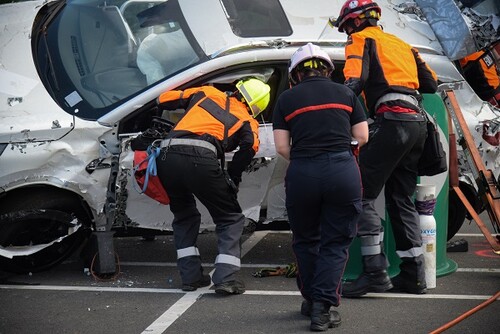See the website of the Rhône Road Trauma Registry
Terms of republication
You can republish this article for free on your website, blog, etc.
The only french database that records injuries from road accidents
Blandine Gadegbeku and Bernard Laumon, epidemiology researchers at l'UMRESTTE, UMR Université Gustave Eiffel and Université Claude Bernard Lyon 1
The Rhône Road Trauma Registry is a unique tool in its field, providing an exhaustive database of road traffic casualties (injured or deceased) in the Rhône since 1995. It is a wealth of information for road safety research, coordinated by UMRESTTE.
After nearly 30 years of existence, over 230,000 victims and 400,000 injuries have been recorded from 38 health establishments including 250 partnered health services. In addition, 85 articles, 25 theses and around 50 projects and studies have been undertaken to better understand road accidents and their consequences on victims. Documenting all victims from road traffic accidents that occur in the Rhône department, and given its contribution to road safety in France, volume of data and longevity, the Rhône Registry represents one of Université Gustave Eiffel’s most outstanding facilities.
Led by a team of around ten researchers, research engineers and physicians at UMRESTTE (Université Gustave Eiffel / Université Lyon 1), the Rhône Road Trauma Registry is a unique tool in its field. “Information is gathered directly from partner health services (combined under Arvac*) from all available sources, making the Registry the most exhaustive database of road trafficvictims ,” says Blandine Gadegbeku, Administrative Manager of the Registry and Deputy Director of UMRESTTE.Paired with data collected by police forces (Onisr), the Registry contributes to estimating the number of seriously injured road users at the national level. Not only does it aim to be exhaustive, but it is also a long-term project: since its creation in 1995, each road casualty in the Rhône is systematically recorded and described. This meticulous work is coordinated by Dr Amina Ndiaye, Deputy Scientific Manager of the Registry.
A precise description of the injuries, victims and circumstances of the accident
What is a serious injury? Through which injury mechanisms do people die? These questions are at the origin of the Registry’s creation. “Previously, the notion of a serious injury was highly administrative and represented a week of hospitalisation. Our aim was to introduce the dimension of health to the world of road safety and to better understand the pattern of victim injuries,” says Bernard Laumon, epidemiologist, Scientific Manager of the Registry and Emeritus Director of Research. For this, the Registry uses the Abbreviated Injury Scale (AIS), an international classification system that makes it possible to precisely describe injuries and their nature. “As it stands, the AIS includes over 2,000 elementary injuries, nine body regions and six levels of severity,” says Blandine Gadegbeku.
As well as this data on injuries and their severity, the Register also gathers information about the victim and circumstances of the accident: was the victim pregnant? What was their means of transport: car, motorbike, bicycle, electric or kick scooter? Were they the driver, or the front or rear passenger? Did they have a protection device: helmet, seatbelt, or airbag? Was it an occupational accident?

A resource for many scientific studies
The Registry represents an invaluable resource for anyone interested in road safety.** “For example, it can be used to evaluate road prevention policies around helmet-wearing: does it reduce the number or severity of injuries? Or, on the contrary, does it have a negative effect?” says Bernard Laumon. “The Registry is a database for research into accident victims or specific types of accidents, such as the study on scooter accidents undertaken in collaboration with Cerema,” says Blandine Gadegbeku. The Registry also provides biomechanicians with the opportunity to refine their models, particularly regarding associations of injuries, economists to study the cost of unsafety on the road with projects such as SafetyCube and Vasem, manufacturers to improve the safety of their cars, and so on. “In the future, we would like to focus on victim outcomes and the long-term consequences of accidents on mental health, life expectancy, pain, cognitive disorders, etc.”
Glossary
Registry: a registry is a continuous and exhaustive base of nominative data relating to one or more health events in a geographically defined population, for research and public health purposes, gathered by a team with the appropriate skills. To become a registry, a database must be evaluated by the Registry Evaluation Committee (CER). There are around 60 registries in France, relating to cancers, cardio or neurovascular diseases, congenital malformations, rare diseases, etc.
Abbreviated Injury Scale: the AIS is a scale to classify the initial injuries of accident victims. Each injury is described using a six-character code that specifies the body region, the affected anatomic structure and the nature of the injury. Each injury is attributed an immediate severity score, accounting for the vital risk, rapidity, complexity and expected duration of care. This score is between 1 (minor) and 6 (fatal).
* Arvac: Association for the Registry of road trauma in the Rhône, which combines all the hospital services that may handle victims of road traffic accidents in the department.
** The Registry is open to public and private actors, whether bilaterally or as part of collaborative projects. Over the years, this remarkable facility has made it possible to create a large number of partnerships with actors such as French or European authorities responsible for defining public policies, car and parts manufacturers, user organisations and other research teams.
Interview performed by the Kogito agency..
Identity card of dataset
| Registry: | Rhône Road Trauma Registry |
| Collected: | since 1995 |
| Contact: | Contact form |
| Key words: | road safety, road accidents, victims, injuries, registry, Rhône department |

![[Translate to English:] Licence creative commons BY-SA 4.0 [Translate to English:] Licence creative commons BY-SA 4.0](https://reflexscience.univ-gustave-eiffel.fr/fileadmin/ReflexScience/Accueil/Logos/CCbySA.png)